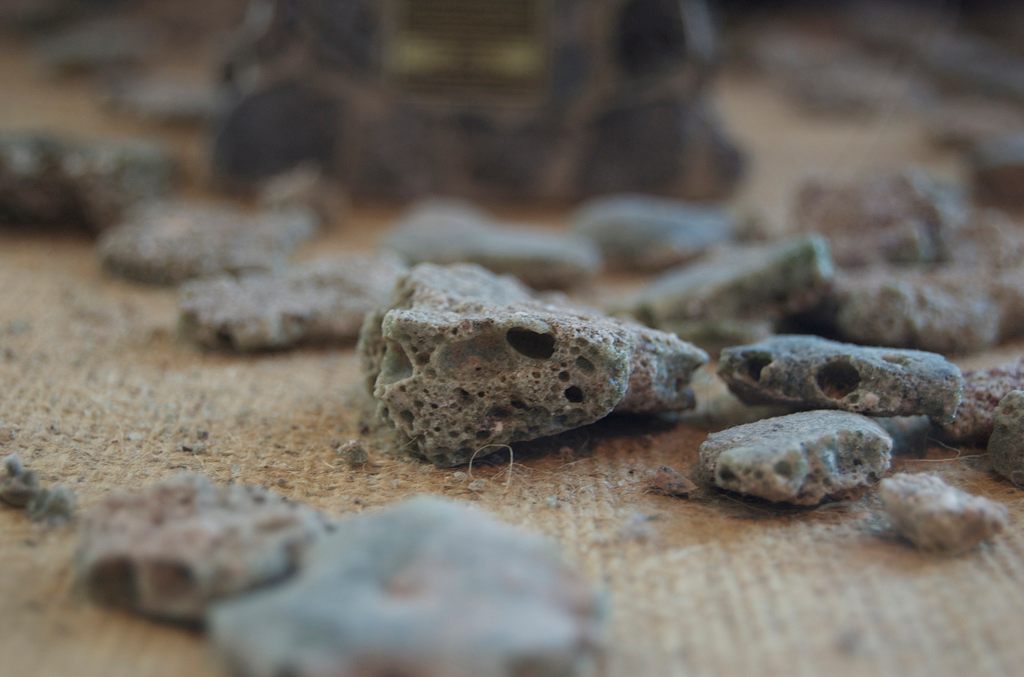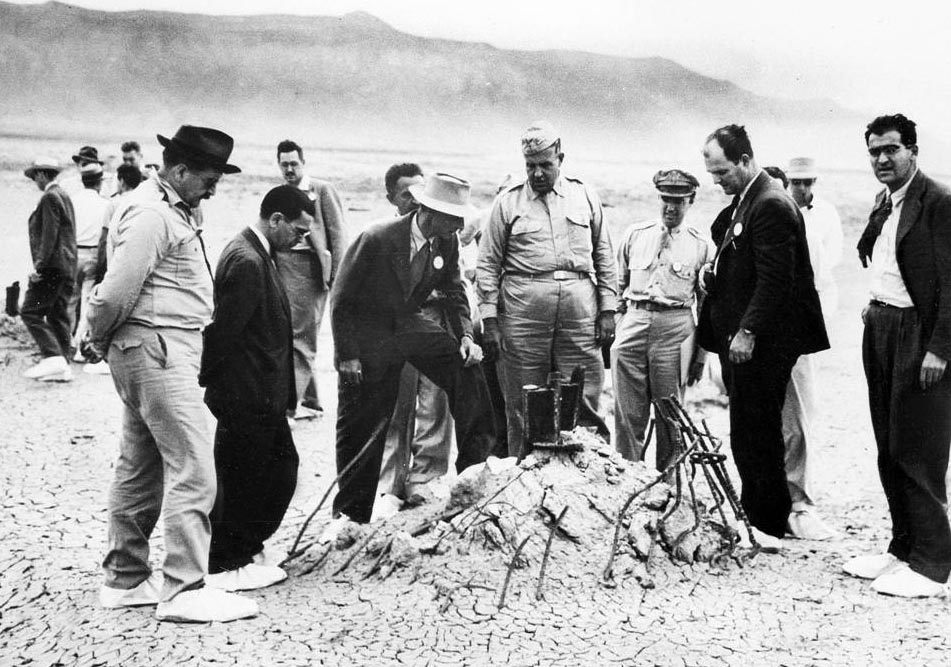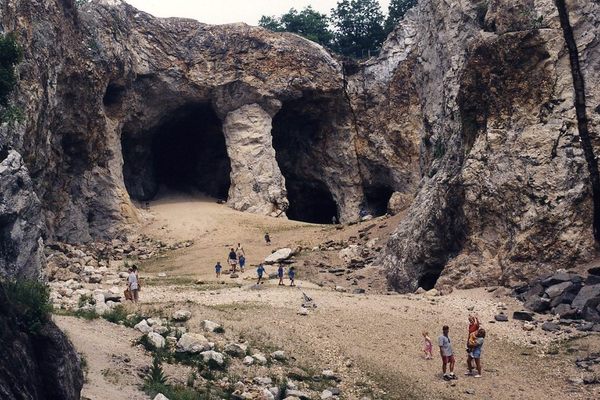The Long, Weird Half-Life of Trinitite
The synthetic material—forged in the blast of the first nuclear bomb test—has been buried, sold, collected, displayed, and even made into jewelry.

As an anthropology student studying nuclear weapons, Martin Pfeiffer has gotten up close and personal with a lot of strange objects. He’s examined preflight controllers. He’s cozied up to bomb casings. (Sometimes he even licks them.)
But one of his favorites is a small rock that he got from a friend just before he started his Ph.D. studies at the University of New Mexico. It’s a tiny piece of trinitite, a unique, glassy, man-made mineral forged in the blast of the first atomic test. His relationship with it is complex: he’s glad he has it, but at the same time, he says, “one of my deepest desires is that nothing like it is ever created again.”
Over the past few years, Pfeiffer has come to realize that he is not alone. Trinitite is polarizing: in his studies, he has come across people who collect it eagerly and people who refuse to touch it entirely; people who study it scientifically and people who sell chunks of it by the side of the road. “Trinitite has a way of concretizing, or creating a link with, the heritage of the first atomic bomb,” says Pfeiffer. “And that can have a lot of stuff attached to it.”

Geologically, trinitite is fairly straightforward. When scientists detonated the first atomic test bomb—nicknamed Trinity—in New Mexico’s Jornada del Muerto desert in July of 1945, the massive explosion threw sand up into the air, where it was liquified instantly by the heat of the blast. By the time it cooled down again, it wasn’t sand anymore: it had reformed into glassy chunks, most an oceanic green. Researchers dreamed up a few different names for it—“atomsite,” or “Alamogordo glass,” after the town near the test—but “trinitite” is the one that stuck.
Culturally, this is one of the weirdest materials we’ve got. Very soon after it was created, it was marshaled for rhetorical purposes—purposes, Pfeiffer says, that it has served ever since. “At the end of the day, trinitite is radioactive fallout,” he says. “But we gave it a pretty name.”
Trinitite.
— Martin Pfeiffer 🖖🏿 (@NuclearAnthro) October 4, 2015
Took years of brilliant effort, engineering, & 2 billion in 1945 dollars but a rare new mineral was made pic.twitter.com/eBMMLpCHYE
Right after the Trinity test, scientists sent out tanks outfitted with soil analyzers, to see how big the explosion had been. They checked the pressure gauges, gamma ray sensors, and neutron detectors that had been installed around the site (the ones that survived the explosion, anyway). Eventually, they ventured out into the newly blasted desert themselves, to see what they could see. Much of this was trinitite, a strange creation left in the destruction’s wake. “The crater seems a lake of green jade… 2,400 feet in diameter,” TIME wrote in September of 1945, after a press trip to the site. “The glass takes strange shapes—lopsided marbles, knobbly sheets a quarter-inch thick, broken, thin-walled bubbles, green, wormlike forms.”

The bomb’s development was famously secret. After the Trinity test, the Air Force told civilians that the overwhelming light and sound was from “a remotely located ammunition magazine” that had accidentally exploded. But by the time of that first press trip eight weeks later, two more atomic bombs—not tests this time—had been dropped on Hiroshima and Nagasaki, instantly killing tens of thousands of people. There was no hiding it anymore.
Instead, those who had worked on the bomb set out to scaffold a certain story around it. “Access to the Trinity site was used immediately after the bombing for propagandistic purposes,” says Pfeiffer. As the people of Japan reported a rising radiation-related death and injury toll from the atomic bombings, scientists toured reporters around the test site, “to scotch these stories,” TIME wrote. (Said stories, of course, would turn out to be true.)
The U.S. Secretary of War, Robert Patterson, stood on the cracked ground and told the press that “there is none of this prolonged radioactivity that the Japanese mentioned.” Dr. Oppenheimer propped a foot on the stump of the destroyed test tower and smiled for pictures.

Trinitite made up a big part of this narrative. “It was explicitly linked to the project of denying that the atomic bombings of Japan could have caused lingering radiation injury,” says Pfeiffer. If the experts could get across that this material—literally made by the bomb, and still swimming with bits of it—was not very dangerous, the rest would follow.
“Reporters… enthusiastically pocketed souvenirs bits of crater glass,” TIME reported. At least one, radio host George Cremeens, posed with a chunk of trinitite in one hand and a cigarette in the other. The scientist Robert B. Fortenbaugh, who worked on the bomb, told his local paper he was “anxious” to head back to the site and pick up some samples.
The man-made mineral even went high fashion: in the fall of 1945, the jewelry designer Marc Koven made earrings, hairpins, and a brooch out of trinitite. (His designs were meant to call to mind the bomb itself, “mushrooming skyward atop a pillar of cloud leaving glassy green devastation behind,” a press release said.) Newspapers around the country reported when the actress Merle Oberon wore the jewelry to a war fundraiser—thus “discounting all Jap claims,” as the Detroit Free Press put it. Other famous women, including model Pat Burrage, also posed for photos decked out in trinitite trinkets.
Trinitite was made into jewelry and used as a political tool to discount claims of Japanese radiation injury. pic.twitter.com/GBKkDBv1ns
— Martin Pfeiffer 🖖🏿 (@NuclearAnthro) June 9, 2017
In the end, this worked a little too well. Although the blast site was open to the general public only two days out of the year, trinitite began rapidly disappearing. “It appears that people snuck in and collected large amounts of it,” says Pfeiffer. In 1952, the Army bulldozed the site, burying the remaining material in the ground. (To this day, ants dig pebbles of it up again, Pfeiffer says.) It’s now illegal for tourists to pocket found trinitite, as signs around the site loudly announce.
All trinitite currently in circulation is fair game, though. People sell it online, and hawk it by the side of the road. (A “Medium Sample” from unitednuclear.com will set you back $69.) People in the business swap it around—Pfeiffer has called it “the traditional gift of nukewonks”—and collectors pay big for special pieces: black-tinted chunks, which contain melted pieces of the site’s iron tower, or reddish ones, which have copper from the cables used to fire the bomb.

Most interestingly to Pfeiffer, museums still display it. The Bradbury Science Museum at Los Alamos has a showcase explaining how scientists have learned more about the bomb by analyzing trinitite. The National Museum of Nuclear Science and History, in Albuquerque, sells it in their gift shop.
At the Trinity site, there’s an exhibit where volunteers wave a Geiger counter over a hunk of trinitite, and then over a piece of vintage Fiestaware, a type of dinnerware glazed with uranium. While both are slightly radioactive, neither delivers a particularly harmful dose, especially now, decades after they were formed. “There’s a connection between [the jewelry] in the ’50s, and having that kind of display set up now,” Pfeiffer says.
Pfeiffer still has that small piece of trinitite his friend mailed him. But he’s also found that its influence isn’t easily contained. It is fallout, after all. “I don’t look at it every day these days,” he says. “As I’ve proceeded in my research, I’ve come to learn—there are reminders of the bomb pretty much everywhere.” Most of them just aren’t quite as shiny.



























Follow us on Twitter to get the latest on the world's hidden wonders.
Like us on Facebook to get the latest on the world's hidden wonders.
Follow us on Twitter Like us on Facebook